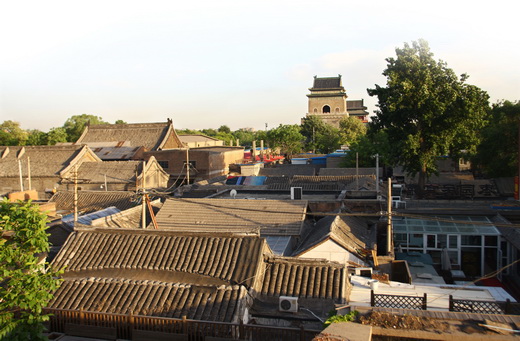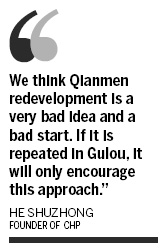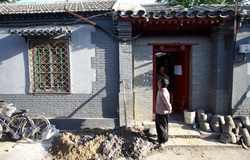Focus
Beating the drum for a city's preservation
By Qin Zhongwei (China Daily)
Updated: 2010-05-26 07:55
 |
Large Medium Small |
|
Above left: A demolished hutong at Gulou. Above right: A worker repairs the roof of a house at Gulou. Below: A bird's view of siheyuan near Gulou. Photos by zou hong / China Daily |

"It is like an antique chair made in the Ming Dynasty, it may look old but it's valuable," He Shuzhong, founder of Beijing Cultural Heritage Protection Center (CHP), a Beijing-based NGO, said of the rapidly vanishing old Beijing at a recent forum on May 23.
The venue for the forum was a restaurant near the New Qianmen Street, which in He's eyes, resembles a poor copy of a precious "Ming Dynasty chair." The street, once home to many teahouses and theaters, symbolized the city's thriving and vibrant neighborhoods. However, the government transformed it into a soulless pseudo-Ming Dynasty commercial street.
The preservation of old Beijing has always been a hot topic amid the city's wide-scale demolition and new construction, but the trigger for the latest wave of debate is the controversial plan to redevelop Gulou, the Drum Tower, one of the few prominent historic landmarks representing the ancient capital that remains.
Gulou, located at the northern end of central axis of the city center in Dongcheng district, was built in 1272. Together with Zhonglou, or the Bell Tower, it is a major tourist attraction as the surrounding hutongs, courtyards, and the residents show a relatively unchanged atmosphere of old Beijing.
In January, however, Yang Yiwen, head of the Dongcheng district government, announced that it planned to restore the area around Gulou and build a "Beijing Time Cultural City."
The proposed 12-hectare "facelift", scheduled to be completed before the end of 2012, proposes a square where public art will be installed to celebrate the time-keeping role of the two towers and an underground complex comprising parking lots, shops and a museum.
The plan immediately provoked a heated response from scholars and netizens.

He Shuzhong is afraid that Gulou will follow the model of Qianmen's redevelopment plan, which he believes is not a successful template for the protection and redevelopment of historic sites.
"We think Qianmen redevelopment is a very bad idea and a bad start. If it is repeated in Gulou, it will only encourage this approach," He was reported as saying by Caing.com.
Hua Xinmin, a long-time activist dedicated to preservation of old Beijing, said Gulou redevelopment, especially the new square, will inevitably result in the demolition of hutongs in the area and the relocation of residents.
"The atmosphere will be gone if the residents and hutongs are no longer there," she told METRO.
There are indeed residents who may want to move, but they should make the decision on their own, rather than being forced to relocate because the hutongs are scheduled to be demolished, He said.
While the public discussion of the issue has intensified, the government and the developer have remained silent.
After the announcement, the Dongcheng government, and the developer, Beijing Oriental Culture Assets Operation Corporation, refused to comment on the issue and the public's concerns. It was not until May 20 that an official of Dongcheng district's office of protection of the historic view, who was not named, defended the government's decision on People.com. cn.
| ||||
But Hua said Gulou is a protected area, and the proposed redevelopment plan will irrevocably destroy the layout of the area, which is not permitted.
"Actually the solution is very simple," she said. "Since the government wants to revive Gulou's time-keeping function, why not just beat the drum and ring the bell on the towers. Why bother to build a new square to remind people of that?" she said.
Yao Yuan, a young scholar of cultural relic preservation, told METRO that European cities such as Venice or Lyon "have been carefully protected and well kept no matter how the city changed, the atmosphere or the texture."
He said they were like museums where you could see the passage of time. "Why can't we do that? " he asked.


